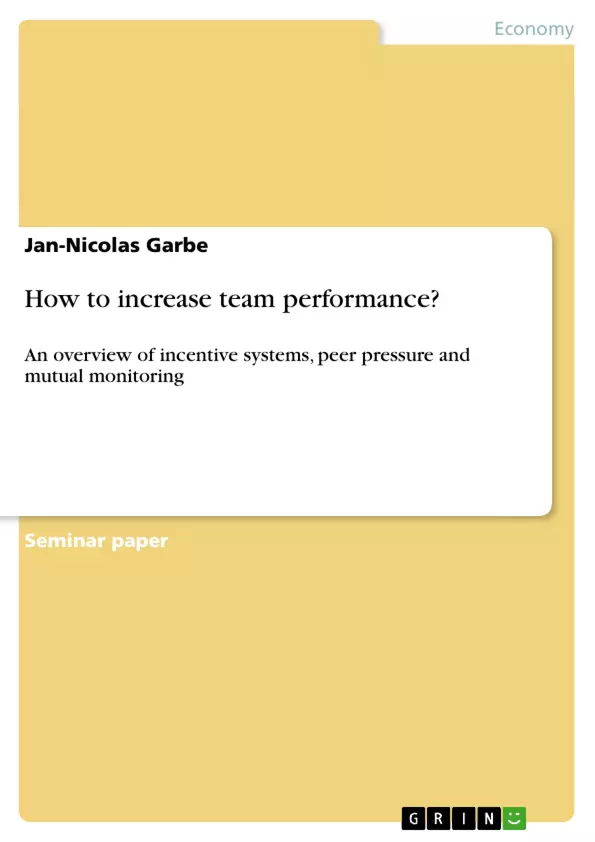During the last decades, researchers in the area of personal economics have developed a bundle of possibilities to increase team performance. This paper wants to give an overview of the latest incentive schemes as well as concepts of peer pressure, norms and mutual monitoring. The findings of this paper are that a well-balanced integrated team incentive plan, which includes elements of rewards and of pressure is expected
to be the most promising. The ideas in this paper are applied to a basic economic model that allows a deeper understanding of the concepts. During the last 20 years, teamwork has become prevalent in many ¯rms. While 1987,
27% of the ¯rms supported self-managed teams, 1999 this number rose to 72% (Lazear
and Shaw (2007)). Together with the increment of usage, the research of teams as
a part of personal economics has increased. Many advantages of teams have been
identi¯ed as reasons for the augmented use of teams. But also the negative e®ects,
organization, coordination and free-riding have been further analyzed. Special attention
was given to the possibilities of increasing the team performance and mitigating the
negative e®ects. During the last decades, researchers and practitioners have developed
a huge array of incentive schemes and bonus plans. These incentives can be monetary,
non-monetary, they can be based on outcomes of the team and team members or on
acquainted team skills. In addition to the incentive schemes, concepts of peer-pressure,
mutual monitoring and punishments were further analyzed and improved. Today, an
integrated, well-balanced usage of the methods promises a considerable improvement
of team performance.
Inhaltsverzeichnis (Table of Contents)
- Introduction
- The benefits of teams
- Specialization
- Knowledge Transfer
- The free-riding effect in teams
- Possibilities to increase team performance
- Incentive schemes and bonuses
- Monitoring, pressure, and punishment
- A model including peer pressure and mutual monitoring
- Numerical example for the model
- Team size and team performance
Zielsetzung und Themenschwerpunkte (Objectives and Key Themes)
This paper aims to provide an overview of recent developments in incentive systems, peer pressure, and mutual monitoring as tools to enhance team performance. The focus is on understanding how these concepts can be integrated into a comprehensive framework for improving team productivity and mitigating the negative effects of free-riding.
- Benefits of teamwork, including specialization and knowledge transfer.
- The free-riding problem in teams and its impact on efficiency.
- Different types of incentive schemes and bonus plans to motivate team members.
- The role of peer pressure, mutual monitoring, and punishment in fostering team performance.
- The application of these concepts in a model that clarifies their dynamics.
Zusammenfassung der Kapitel (Chapter Summaries)
- Introduction: This section sets the stage by highlighting the increasing prevalence of teamwork in organizations and the growing body of research on team performance. It emphasizes the need for effective strategies to maximize team productivity and minimize the downsides of team dynamics.
- The benefits of teams: This chapter delves into the advantages of teamwork, focusing on specialization and knowledge transfer. It argues that when individuals have complementary skills and can effectively share knowledge, teams can achieve greater efficiency and effectiveness than individuals working alone.
- The free-riding effect in teams: This section explores the free-riding problem, a common challenge in team settings. It explains how individual members may be tempted to shirk responsibility and rely on the efforts of others, leading to suboptimal performance. The chapter utilizes a basic model to illustrate this phenomenon.
- Possibilities to increase team performance: This chapter introduces strategies for improving team performance, focusing on two primary approaches: incentive schemes and bonuses, and monitoring, pressure, and punishment. The section provides a brief overview of each approach, highlighting their potential to motivate team members and enhance productivity.
- A model including peer pressure and mutual monitoring: This chapter delves into a specific model that incorporates peer pressure and mutual monitoring. It explains how these elements can contribute to improved team performance by encouraging cooperation and discouraging free-riding behavior.
- Numerical example for the model: This chapter provides a numerical example to illustrate the practical application of the model presented in the previous section. It helps to visualize how the dynamics of peer pressure and mutual monitoring can influence team outcomes.
Schlüsselwörter (Keywords)
The main keywords and topics of this paper are: team performance, incentive systems, peer pressure, mutual monitoring, free-riding, team dynamics, specialization, knowledge transfer, economic modeling, and team productivity.
- Quote paper
- Dipl. Ing. oec. Jan-Nicolas Garbe (Author), 2008, How to increase team performance?, Munich, GRIN Verlag, https://www.grin.com/document/90472



